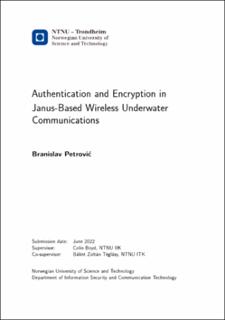| dc.contributor.advisor | Boyd, Colin Alexander | |
| dc.contributor.advisor | Téglásy, Bálint Zoltán | |
| dc.contributor.author | Petrović, Branislav | |
| dc.date.accessioned | 2022-10-07T17:19:25Z | |
| dc.date.available | 2022-10-07T17:19:25Z | |
| dc.date.issued | 2022 | |
| dc.identifier | no.ntnu:inspera:107093487:69827044 | |
| dc.identifier.uri | https://hdl.handle.net/11250/3024587 | |
| dc.description.abstract | Trådløs undervannskommunikasjon finner vanligvis sted ved hjelp av akustiske bølger på grunn av deres overlegne robusthet og rekkevidde sammenlignet med radiobølger eller andre kommunikasjonsmedier. Men akustiske bølger lider fortsatt av høyt pakketap og de gir en lav datahastighet. I tillegg er det meste av informasjon sendt ved hjelp av akustiske bølger under vann i dag ukryptert og ikke autentisert. Med den stadige utviklingen av undervannsmiljøer i dag, er det et økt behov for databeskyttelse blant marine operatører, siden trussellandskapet under vann utvides raskt med nye typer angrep, som avlytting, rutingangrep og tukling av data.
For å overvinne disse problemene foreslår vi i denne oppgaven to sikkerhetsløsninger integrert med den første standarden for akustisk undervannskommunikasjon, Janus. Målet er å motvirke truslene, med tanke på begrensningene til de akustiske kommunikasjonskanalene. De foreslåtte løsningene er basert på symmetrisk kryptografi. Vi baserer arbeidet i denne oppgaven på den første løsningen for gjensidig kryptografisk autentisering blant undervannsutstyr, foreslått av Téglásy m. fl. Det endelige målet er å muliggjøre det for undervannsnoder å utveksle autentisert og kryptert informasjon.
Vi inkluderer en sikkerhetsanalyse av de foreslåtte sikkerhetsløsningene basert på en gjennomgang av det generelle trussellandskapet under vann, samt generelle sikkerhetskrav til akustisk undervannskommunikasjon. Analysen viser at løsningene gir høy sikkerhet mot angrep på de foreslåtte protokollene og mot tukling med kommunikasjonskanalen.
Vi simulerer de foreslåtte løsningene ved å inkorporere dem i den eksisterende implementeringen av Janus og biblioteket for akustiske undervannsnettverk til nettverkssimulatoren NS3. Simuleringene viser at autentiseringsprotokollene basert på de foreslåtte ordningene fullføres innen en akseptabel tidsramme i forhold til de generelle kommunikasjonskravene. | |
| dc.description.abstract | Wireless underwater communications commonly utilize acoustic waves due to their superior robustness and range compared to radio waves or other transmission media. But usage of acoustic waves still suffers from high packet loss and it provides a low data rate. In addition, most information sent using acoustic waves under water today is unencrypted and not authenticated. With the development of underwater environments, there is an increased need for data protection among marine operators, since the underwater threat landscape is rapidly broadening with new kinds of attacks, such as eavesdropping, routing attacks, and data tampering.
To overcome these problems, in this thesis, we propose two security schemes integrated with the first standard for acoustic underwater communication, Janus. The aim is to counteract the threats, bearing in mind the limitations of the acoustic communication channels. The proposed schemes are based on symmetric cryptography. We base the work in this thesis on the first solution for mutual cryptographic authentication among underwater devices, proposed by Téglásy et al. The ultimate goal is to provide a way for underwater nodes to exchange authenticated and encrypted information.
We include a security analysis of the proposed security schemes based on a review of the general underwater threat landscape and general security requirements of underwater acoustic communication. The analysis shows that the schemes provide a high level of security against attacks on the proposed protocols and against tampering with the communication channel.
We simulate the proposed schemes by incorporating them in the existing implementation of Janus and the Underwater Acoustic Network (UAN) library of the Network Simulator 3 (NS3) network simulator. From the simulations, we show that the authentication protocols based on the proposed schemes complete within an acceptable time frame relative to the general communication requirements. | |
| dc.language | eng | |
| dc.publisher | NTNU | |
| dc.title | Authentication and Encryption in Janus-Based Wireless Underwater Communications | |
| dc.type | Master thesis | |
